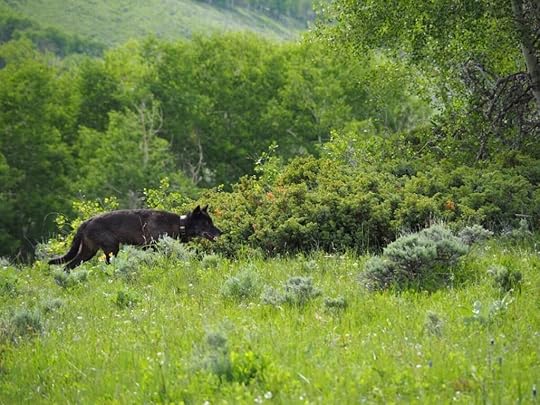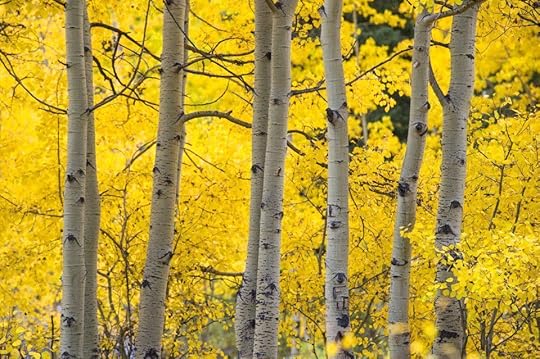Link between wolves and aspen a point of debate beyond Colorado
 A Collared wolf moves through greenery. Photo courtesy Colorado Parks and Wildlife
A Collared wolf moves through greenery. Photo courtesy Colorado Parks and WildlifeFor the past 15 years, Luke Painter has been traveling to the northern range of Yellowstone National Park, where mountains rise and tributaries carve valleys of sage, willows and trees. This includes aspen, the beloved tree of fall that glows around this time of year as the season turns, catching the eye of Painter from his camper van that serves as his research hub.
His interest has gone far beyond aesthetics.
“I’ve just gotten really interested in this whole ecological process and how that’s developing,” said Painter, who teaches ecology and conservation at Oregon State University.
Conveniently, northern Yellowstone “has become a living laboratory for studying the interactions of aspen and other deciduous plants, large herbivores and large carnivores,” explains his latest paper in the journal Forest Ecology and Management.
The area is a living laboratory in the wake of wolf reintroduction, which began in 1995. And according to Painter’s latest work, the area demonstrates what might be a surprising link between the tree that is Colorado’s favorite and the animal that is its most controversial.
As Coloradans go leaf peeping in the weeks ahead, they probably won’t be thinking about wolves and the debate that has roiled the state since reintroduction started on the Western Slope in 2023. But aspen and wolves have indeed been on the mind of Painter as he’s continued surveys of predecessors.
His new paper reports a milestone: Sampled sites showed “the first documented recruitment of overstory aspen trees in northern Yellowstone since the 1940s.”
Painter emphasized a “mixed bag” overall; a third of the sites showed “saplings throughout” and another third “had patchy sapling recruitment.”
But “that’s all a big change from what we had in the past, which was nothing at all,” Painter said.
Whole swaths of aspen had been found to be chewed away by elk in the decades after wolves were extirpated. Elk are known to be prolific “browsers.” And without their prolific predator, their numbers were found to boom in areas where aspen struggled to regenerate as they naturally do, ensuring habitat for a vast array of plants and creatures that depend on the overstory.
This was part of the conversation leading up to Yellowstone’s wolf reintroduction in the ‘90s. Researchers have since explored the question: How would aspen and other important, browsed-upon species like willow respond?
“People have argued a lot about what factors have caused a decrease to the elk population, and it’s true, there are other factors involved,” Painter said. “But we would not be seeing the sustained reduction to elk numbers in the park without wolves. … They have made a big difference.”
But critics say the new research suggests too clear a link between the predator and aspen.
 Aspens show their golden colors Tuesday, Sept. 20, 2016, on Guanella Pass near Georgetown, Colo. (The Gazette, Christian Murdock)
Aspens show their golden colors Tuesday, Sept. 20, 2016, on Guanella Pass near Georgetown, Colo. (The Gazette, Christian Murdock)Media accounts have further oversimplified the connection, a statement from Colorado Parks and Wildlife suggested: “However, this popularized story has been called into question by recent research, which has shown that aspen recovery has been much slower than some initial studies indicated.”
That’s according to research from a paper published last year, also out of northern Yellowstone. Tom Hobbs, professor emeritus at Colorado State University, was the paper’s lead author.
Increased hunting around Yellowstone’s peripheries has played a major factor in elk numbers, he told The Gazette. “And at the same time wolves were recovering, so were cougars and grizzly bears. And it’s pretty well known cougars are actually more effective predators on elk than wolves are.”
Generally speaking, aspen are helped by a natural “food web” that includes wolves, Hobbs said. “But can we say in the relatively few decades that have passed since they were reintroduced (in Yellowstone) that they caused widespread ecosystem restoration? No, I don’t think so.”
Painter again emphasized the “mixed bag” of his study. Another 38% of sampled aspen sites “had few or no saplings,” the paper reads — the result of continued browsing and perhaps more trampling bison, Painter said.
Still, the paper sides with a contended trophic cascade — ecological restoration linked to a top predator. The debate continues in Yellowstone, as it does in Colorado, where the wolf controversy has more so focused on predated livestock and an altered way of life for ranchers.
As for aspen, it’s “certainly something CPW is interested in,” the agency said in response to questions from The Gazette. The statement referred to the trees providing habitat “for at least 29 species of greatest conservation need as identified in the State Wildlife Action Plan from 2015.”
However, overbrowsing “is not a widespread issue that is a concern of CPW,” the agency said, citing harvest numbers “helping hold ungulate herds to the population objectives established by our biologists.”
But in states without a native predator, overbrowsing has been a top concern for Paul Rogers. He’s a Utah State University professor who leads the Western Aspen Alliance, a multi-agency organization seeking to improve aspen ecosystems.
Rogers sees wolves as keeping elk moving in and out of young aspen stands — and “not just the two or three weeks of hunting season, but year-round,” he said. “That’s a problem in a lot of places, the sedentariness.”
Early into wolf reintroduction in Colorado, the question of impact is premature, Rogers said. “But I do think there’s a link that needs to be made between wolves, elk, aspen and biodiversity.”
Painter continues to explore the link; he was recently back in Yellowstone before the season turned. He was asked about the experience. “I hesitate to make a value statement,” he said, as any scientist hesitates to include emotion in the process.
And yet he recognized “the human effect” aspen has. “I want to cheer for them,” he said.



